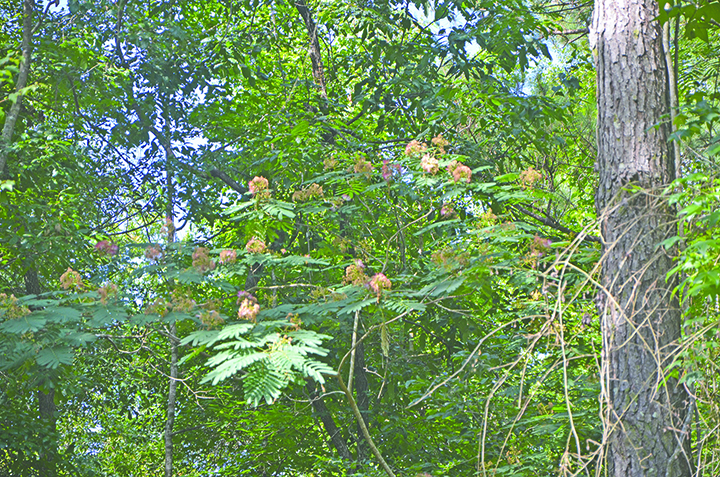Les Harrison
Contributor
With the onset of summer, the many trees and plants have already bloomed and are settling into the green background. An exception are the Mimosa trees, Albizia julibrissin, which are blooming profusely.
These once popular small trees are commonly found in the yards of older homes in Madison County, where the display of prolific pink blooms starts up as the weather warms.
It also happens to be an invasive species native to south western and eastern China, not Florida. Because it was imported many years ago, many Florida residents may not realize this tantalizing beauty is actually an aggressive invader in disguise.
In its wild native habitat, these trees are frequently found in dry plains, sandy valleys and uplands environments. As an exotic, it has spread from southern New York, west to Missouri, south to Texas. It is even considered an invasive species in Japan.
Worse yet, the mimosa is guilty of harboring a fungal disease, Fusarian, which will negatively affect desirable landscape plants. Many palms, as well as a variety of edibles, including tomatoes, peppers, watermelon and bananas will succumb to this pathogen.
While outwardly charming in appearance to those looking for a colorful tree, this is a beauty and the beast combo tree with too many problems to compensate for its looks.
A plant is considered exotic when it is out of its native range. “Invasive” means it is capable of more than just surviving beyond its original range. They will reproduce and spread to yards and wild areas, but will also crowd out the ornamentals or native plants which should be growing there.
For the homeowner, this can mean extra weeding time and expense. In natural areas, the invader will disrupt not only other plants, but also the birds, mammals, amphibians and insects that depend on the displaced plants for food, shelter and habitat. Other negative traits include the disruption of water flow and aiding the incidence of wildfires.
Invasive species in yards and landscapes run the serious risk of disrupting the time-tested natural processes. Even if an invasive seems to be under control, there is always the chance of wind, water, birds, or other creatures spreading parts of the plant which can reproduce.
The Mimosa tree is a classic example of this. In natural areas, mimosas tend to spread into dense clumps, blocking the light to native plants which prevents them from growing. They are prominent along the edges of woods and wetland areas where seeds scatter easily and take advantage of sheltered, sunlit spots.
Mimosa tree seeds can stay viable for many years in the soil. These seeds will float, without damage to their germination potential, until they wash ashore to colonize a new site.
Additionally, Mimosa tree seeds are attractive to wildlife. One tree in a yard can infest many acres with the aid of birds and small mammals.
To remove existing Mimosa trees, cut close to the ground then quickly paint the top of the stump with herbicide to prevent re-sprouting. Untreated cut or wind snapped trees quickly regrow from the stump, making this one invader difficult to eradicate.
Fortunately, there are many attractive small trees which can replace the Mimosa tree in home landscapes.
To learn more about this pretty problem in the City of Madison, Cherry Lake and Madison County, contact the nearest UF/IFAS County Extension Office or visit https://sfyl.ifas.ufl.edu/find-your-local-office/. To read more stories by Les Harrison visit Outdoorauthor.com and follow him on Facebook.

